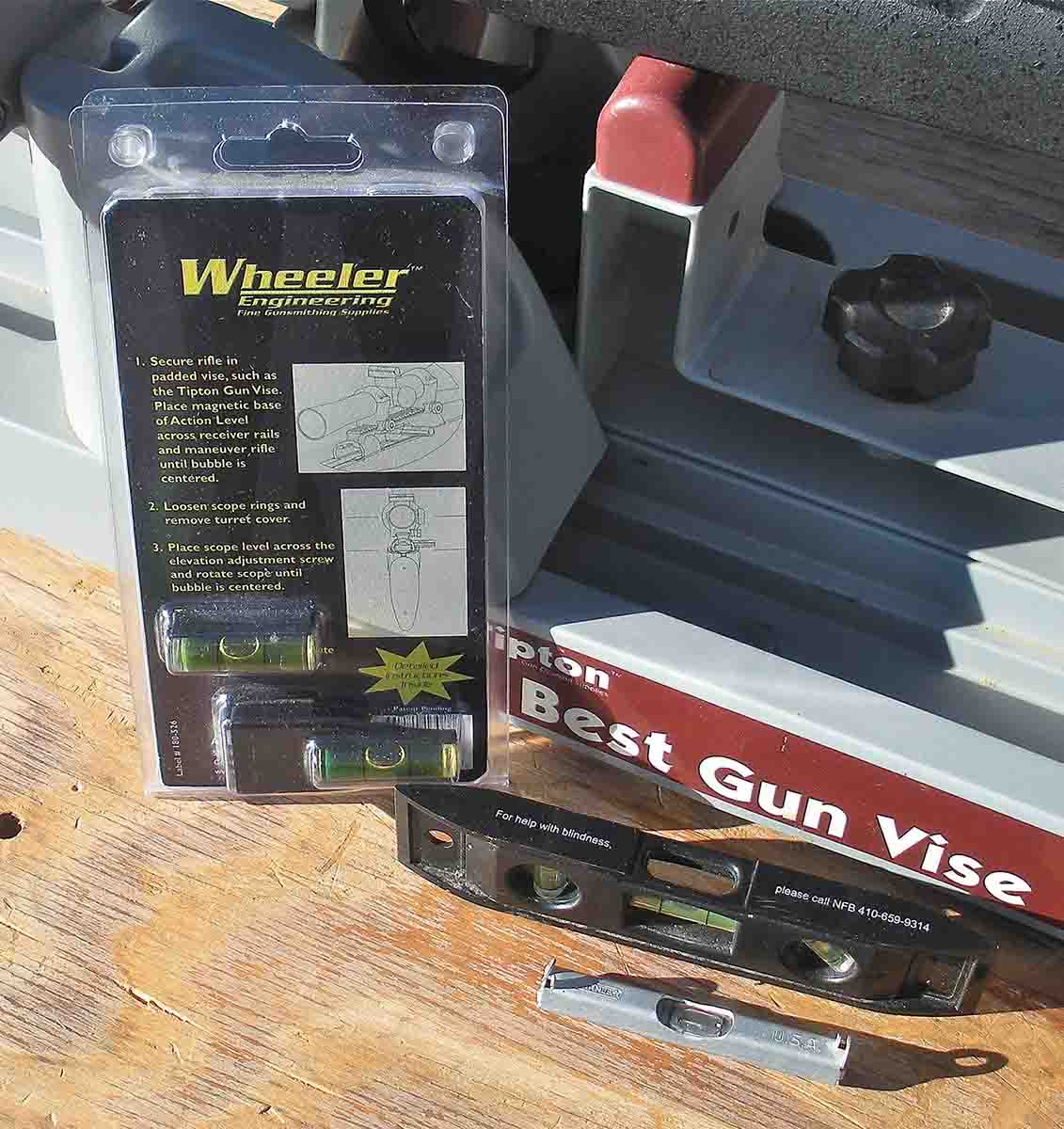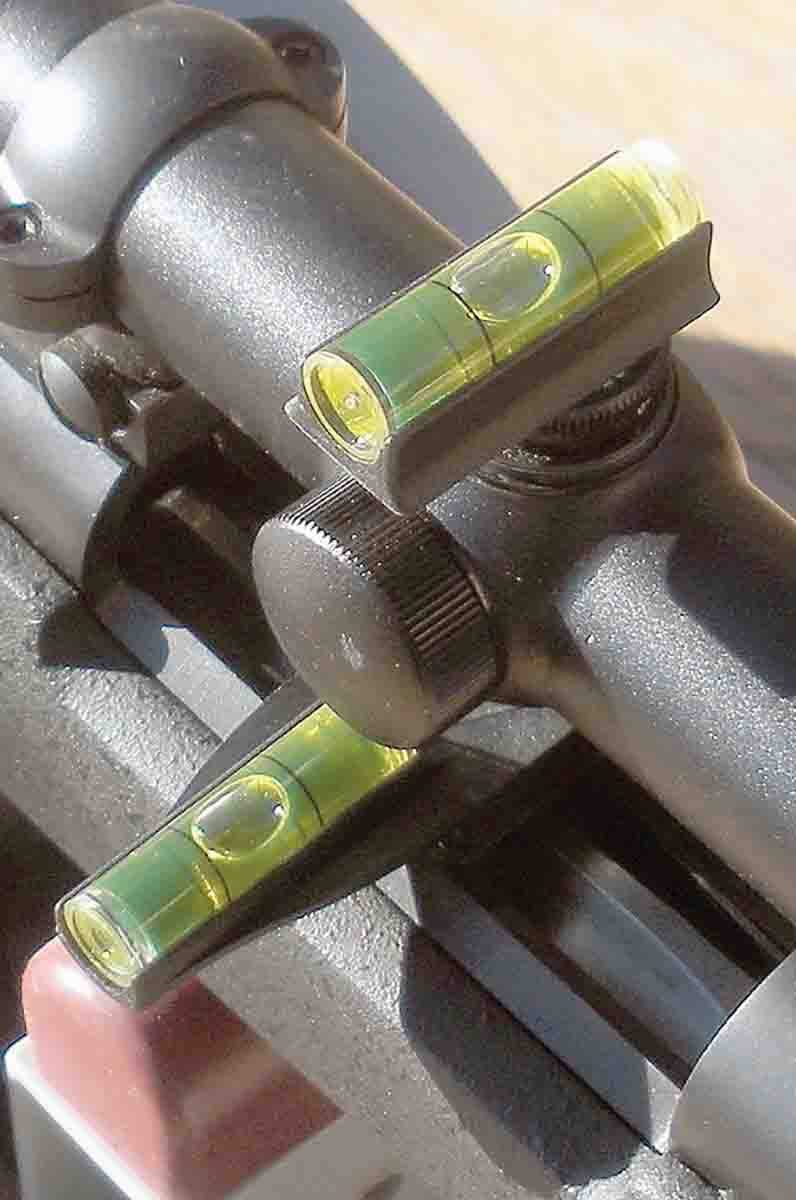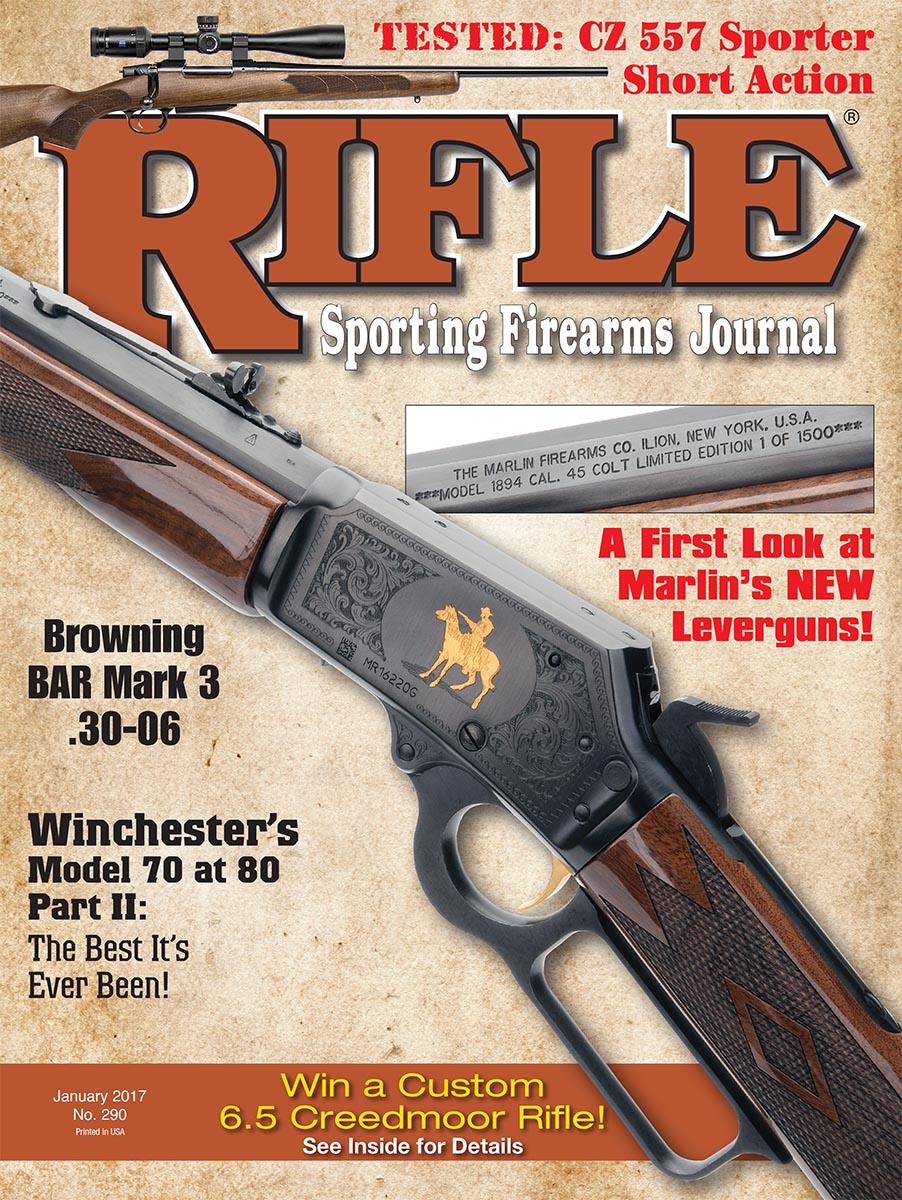Spotting Scope
Wheeler Engineering Level-Level-Level
column By: Dave Scovill | January, 17

The other problem was that the scope appeared canted, enough so that each time the rifle was mounted to my shoulder, it required a bit of adjustment to bring the vertical crosshair straight up and down. It was only the second rifle I had used with a scope, so it was left as it was until I had time to fiddle with it, mostly because I hadn’t figured out if the scope was canted, or I was holding it cattywampus, or a little of both.
Eventually the rifle was mounted in a bench vice using heavy sad-dle leather to protect the stock. With the vertical crosshair aligned on the side of a square piece of cardboard tacked to a post and checked for level with a carpenter’s level, the view from behind the rifle revealed the stock was canted to the right, which meant the reticle was canted to the left.
The solution was to loosen the screws on the Weaver rings, turn the scope to the right (clockwise), and retighten the screws. Unfortunately, when the scope reticle was adjusted to vertical and horizontal on the cardboard and the stock was not canted, the scope turned when the two screws on the side of the Weaver rings were tightened, sort of a “Catch 22.”

Sometime later the same problems cropped up with a new Ruger Model 77, but a small string level was positioned across the integral scope bases, front or back, to adjust the rifle so the bases were level. With the rifle secured in a padded vice, the lower half of the Ruger rings were mounted on the receiver. The scope was then placed gently into the lower half of the rings. With the vertical turret cover removed from the Weaver 6x, the turret was flat enough to lay the string level across it, so the scope could be rotated to adjust the reticle on a square target. The trick was doing all this without disturbing the rifle while the scope was mounted and the screws were tightened.
Working with Leupold rings and bases a few years later, the rings were secured to a one-inch diameter wooden rod to turn the front and rear rings around until the rear ring was pretty much centered over the rear base, where the windage screws were tentatively tightened. Then the windage screws were adjusted to bring the bore-sighted barrel and the scope reticle to the same point on a target posted about 25 yards from the rifle. (If the rifle is squared prior to turning the front ring around, it is nearly impossible to maintain the rifle in position, even when secured in a vice, while turning the front ring in the base.)
Over the years of mounting dozens of riflescopes, it is apparent that not all rifles that require scope bases have screw holes that are in perfect alignment from the front to the rear base. Rifles with integral bases are not necessarily squared with each other, front to back, either, at which point there is no way to determine which base is square with the rifle. Either way, it pays to check for level on both bases.
For the last couple of years, I’ve used the Wheeler Engineering Crosshair Leveling Kit (aka, Level-Level-Level) that includes two bubble levels. One is used to lay across the upper scope turret, with the cover removed, or not, depending on whether the turret cap is flat on top. The other level has a magnetic base that fits between the action rails, assuming it is a two-lug bolt action, otherwise it can be positioned across the front or rear scope base to level the action, whereupon it is difficult to keep the rifle from moving slightly while the scope is positioned and the screws are tightened. Either way the Wheeler kit offers an improvement over carpenter levels and/or string levels.
The Wheeler level kit is easy to work with, assuming folks don’t get too ham-handed, especially if you just want to check for cant on a rifle that has a scope mounted on it. To mount a scope, avoid bumping the rifle or the scope once they are square with each other, and turn the ring screws gently. Instructions recommend the Tipton Gun Vice (approximately $100.00 at the local Sportsman’s Warehouse) to hold the rifle securely and avoid any shifting around while working. A bench-type vice works, if it is large enough, say 5- to 6-inch jaws or larger, and assuming thick padding is used between the jaws and the stock.
The Wheeler kit also makes it possible to determine if the scope bases are square with each other, or not, by laying one level across the front or rear base and the other across the receiver rails. Leaving the latter in place, move the other level from the front to rear base, or vice versa, to see which one jives with the receiver level. Most levels will give a different reading if they are turned around 180 degrees, back and forth, but at most it is usually limited to one-sixth bubble or less and doesn’t present a serious error.
The Wheeler kit instructions state that most folks are unaware their scope is canted, because they have gotten used to it and unconsciously hold accordingly to square the reticle up with what they see in the scope. As a result, it is best to assume the reticle and action are not perfectly square. In checking a few scoped bolt actions that were set up using the carpenter’s level and string level and used alternately over the last 15 or 20 years, two were perfect, the others were off on average by one-eighth to one-sixth bubble from center. Since most of those rifles belong to my wife, Roberta, and since she hasn’t missed or wounded any of the elk she put a tag on, it may be safe to assume they are close enough for normal hunting conditions, 400 yards or less.
One of the best reasons for bringing all this up at this point is the current interest in long-range shooting, which with a canted scope and/or rifle makes it increasingly difficult to maintain groups on point-of-aim as range increases. In effect, when the vertical crosshair is canted to the right (clockwise) and the shooter unconsciously holds it plumb, bullets print to the right and move
toward point-of-aim and migrate progressively to the left beyond point-of-aim. Additionally, as the height of the reticle above the barrel increases, owing large objective bells on scopes that generally require higher mounts and rings, bullet migration increases with scope height and the degree of angle that it is canted. If that sounds overly complicated, don’t sweat the gory details, just purchase the Wheeler kit and make sure the reticle isn’t canted.
The last step in all this is to bore sight the rifle. For most rifle/ cartridges, a range of 25 yards works fine to help get the rifle on paper at 50 to 100 yards, then proceed to fine tune the point of bullet impact at the range of interest. For the last several years, I’ve used the top of a fence post that is about 25 yards from a bench vice or the Tipton Gun Vice in the garage. The objective is to get the rifle bore pointed at the same spot as the center of the reticle. A black dot about one inch in diameter on a piece of paper tacked to the top of the post is clearly seen with the naked eye through the bore at around 20 to 25 yards in good light and is easily visible through the scope that is set between the lowest and highest power. The trick is to keep the rifle/scope from wiggling while the scope is adjusted to point where the bore is centered, in that order.
A couple of years ago, a friend brought a laser bore scope to hunting camp in Kansas, thinking it would do for bore sighting with a scope. With a target tacked to a fence post at 35 yards or so, the laser bore sight failed to offer a consistent point of aim for the scope if the laser was removed from the rifle chamber and then replaced to take a second or third reading. We eventually centered the bore on the target and adjusted the scope reticle accordingly.
Whether or not that laser bore sight was typical of the breed, I have no idea, but from our experience, it requires verification against the standard bore sighting method to ensure its accuracy compared to eyeballing down the barrel.
In addition to bore sighting, a reticle collimator helps make sure the center of the crosshairs are aligned with the rifle bore. This will also verify whether or not the factory setting for the reticle is indeed centered in the scope tube. Most are, so it should only require a minor adjustment, a few clicks up or down, to align the reticle with the bore. For the most part, the collimator will get the rifle on paper at 50 yards for the first shot so ammunition isn’t wasted. Most of the time, it will get the rifle on paper at 100, but firing at least one shot at 50 yards avoids having to move the target back and forth unnecessarily and/or ending up wasting time and expensive factory loads, or meticulously prepared handloads, in an attempt to get the bullets to print where the scope is pointed.


